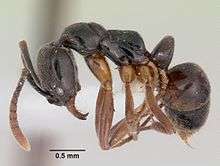Brachyponera chinensis
Brachyponera chinensis, or the Asian needle ant, is a ponerine ant native to areas of Japan and Asia.[1] The species can also be found in the United States,[2] where it is an adventive and possibly invasive species. It is documented from Georgia, Kentucky[3], North Carolina, South Carolina, and Virginia, though unpublished records place it in Alabama and Tennessee.[4] Sightings have been confirmed as far north as Maryland.[5] The pest species is of growing concern due to ecological impacts on biodiversity[6] and medical risks to human health, via sting-induced anaphylaxis.[1] It prefers nesting in dark, damp areas in soil beneath stones, logs, stumps, and debris.[4]
| Brachyponera chinensis | |
|---|---|
 | |
| B. chinensis worker from the United States | |
| Scientific classification | |
| Kingdom: | |
| Phylum: | |
| Class: | |
| Order: | |
| Family: | |
| Subfamily: | |
| Genus: | |
| Species: | B. chinensis |
| Binomial name | |
| Brachyponera chinensis (Emery, 1895) | |
The Asian needle ant and the Argentine ant (Linepithema humile) have been battling for territory in the U.S.[7]
References
- Mark P. Nelder; Eric S. Paysen; Patricia A. Zungoli & Eric P. Benson (2006). "Emergence of the introduced ant Pachycondyla chinensis (Formicidae: Ponerinae) as a public health threat in the southeastern United States". Journal of Medical Entomology. 43 (5): 1094–1098. doi:10.1603/0022-2585(2006)43[1094:EOTIAP]2.0.CO;2. PMID 17017251.
- Joe MacGown. "Ants (Formicidae) of the southeastern United States". Mississippi Entomological Museum. Retrieved 18 April 2011.
- Pratt, Katie (June 10, 2020). "New stinging ant species could cause problems for Kentuckians". UKNow. Retrieved June 30, 2020.
- Pat Zungoli. "Asian needle ant, Pachycondyla chinensis (Emery)". Household & Structural Urban Entomology. Clemson University. Archived from the original on 15 January 2011. Retrieved 18 April 2011.
- "Maryland Biodiversity Project - Asian Needle Ant (Brachyponera chinensis)". www.marylandbiodiversity.com. Retrieved 2016-09-28.
- Benoit Guénard & Robert R. Dunn (2010). "A new (old), invasive ant in the hardwood forests of eastern North America and its potentially widespread impacts". PLoS ONE. 5 (7): e11614. doi:10.1371/journal.pone.0011614. PMC 2908120. PMID 20657769.
- Ants Misbehaving: Argentine and Asian Ants Battle for U.S. Dominance; "In a fierce battle for dominance, Asian needle ants are displacing other species and threatening U.S. ecosystems" May 5, 2013 Scientific American